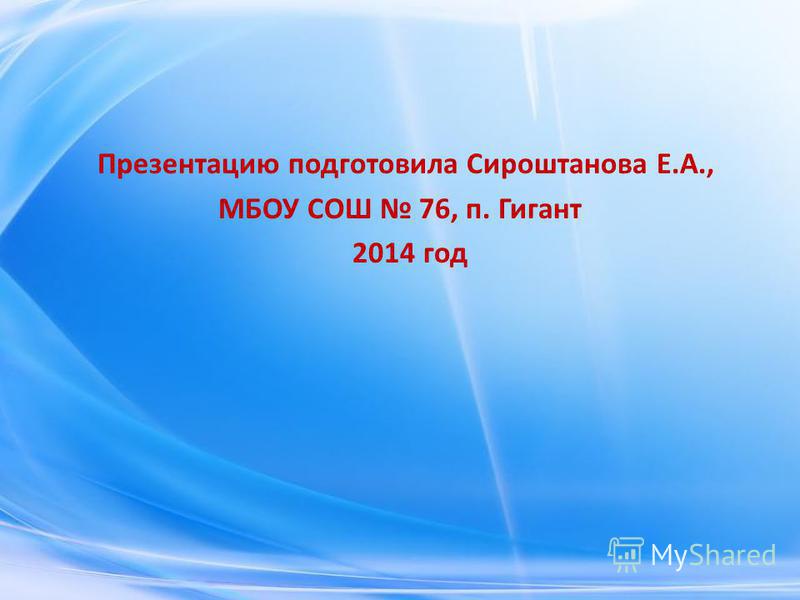Презентация на тему новая зеландия. Презентация на тему «Новая Зеландия» в формате powerpoint. Фрагменты из презентации
Презентация на тему «Новая Зеландия» по географии в формате powerpoint. Интересная презентация для школьников рассказывает о природе, экономике, населении, культуре Новой Зеландии.
Фрагменты из презентации
- Площадь 269 675 кв.км;
- Население 3 620 000 человек;
- Средняя плотность населения 12 чел/кв.км;
- Средняя продолжительность жизни:
- мужчины – 75 лет,
- женщины – 80 лет;
- Состав:
- европейцы – 88%,
- маори – 9%,
- жители островов Тихого океана – 3%;
- Форма правления: конституционная монархия;
- Глава государства: королева Великобритании, представленная генерал-губернатором;
- Государственный язык: английский;
- Религия: христианство;
- Географическое положение: Океания;
- Крупнейшие острова: Северный и Южный.
Особенности рельефа
- Гористые острова;
- Сейсмическая активность;
- Действующие вулканы;
- Гейзеры;
- Горячие минеральные источники.
Климат: субтропический морской
- Средние температуры июля 5 – 12 С
- Средние температуры января 14 – 19 С
- Осадки: 400 -600 мм в год
Промышленность
- Занято 19% трудоспособного населения;
- Дает 31% ВВП;
- Машиностроительные, металлургические и текстильные предприятия сосредоточены в крупных портовых городах.
Сельское хозяйство
- 46% всего экспорта приходится на сельскохозяйственную продукцию: мясо, масло, сыр, шерсть;
- Развиты лесное хозяйство, лесозаготовки, деревообрабатывающая, целлюлозно – бумажная отрасли.
Сфера обслуживания
- Развивается туризм;
- В сфере обслуживания работает 71% населения.
Транспорт
- Длина железнодорожных путей 4200 км;
- Длина шоссейных дорог 93 300 км;
- Паромные маршруты Веллингтон – о.Южный;
- Международные аэропорты: Окленд, Крайстчерч, Веллингтон;
- Морской транспорт;
Столица – Веллингтон
- Город расположен на северном берегу пролива Кука, в бухте Потр-Никольсон;
- Площадь125 кв.км;
- Население 158 тысяч человек;
- В сентябре 1839 года группа белых переселенцев приобрела у местного племени маори участок, на котором был построен город, названный в честь фельдмаршала Веллингтона, командовавшего английскими войсками в сражении при Ватерлоо.
Вклад в цивилизацию. Эрнст Резерфорд (1871–1937)
- Величайший физик – экспериментатор двадцатого столетия;
- Центральная фигура в познании радиоактивности, заложил основы ядерной физики. Его открытия получили широкий спектр применения, включая ядерное оружие, атомные электростанции, радиоактивные исчисления, исследования радиации.
Культура
Отражены элементы европейских, полинезийских, азиатских культурных традиций, привнесенных выходцами из многих стран мира, поселившимися здесь.
Содержание Особенности населения Особенности населения Особенности населения Особенности населения Форма правления Форма правления Форма правления Форма правления Географическое положение Географическое положение Географическое положение Географическое положение Особенности рельефа Особенности рельефа Особенности рельефа Особенности рельефа Климат Климат Климат Промышленность Промышленность Промышленность Сельское хозяйство Сельское хозяйство Сельское хозяйство Сельское хозяйство Сфера обслуживания Сфера обслуживания Сфера обслуживания Сфера обслуживания Транспорт Транспорт Транспорт Столица Столица Столица Вклад в цивилизацию Вклад в цивилизацию Вклад в цивилизацию Вклад в цивилизацию Культура Культура Культура
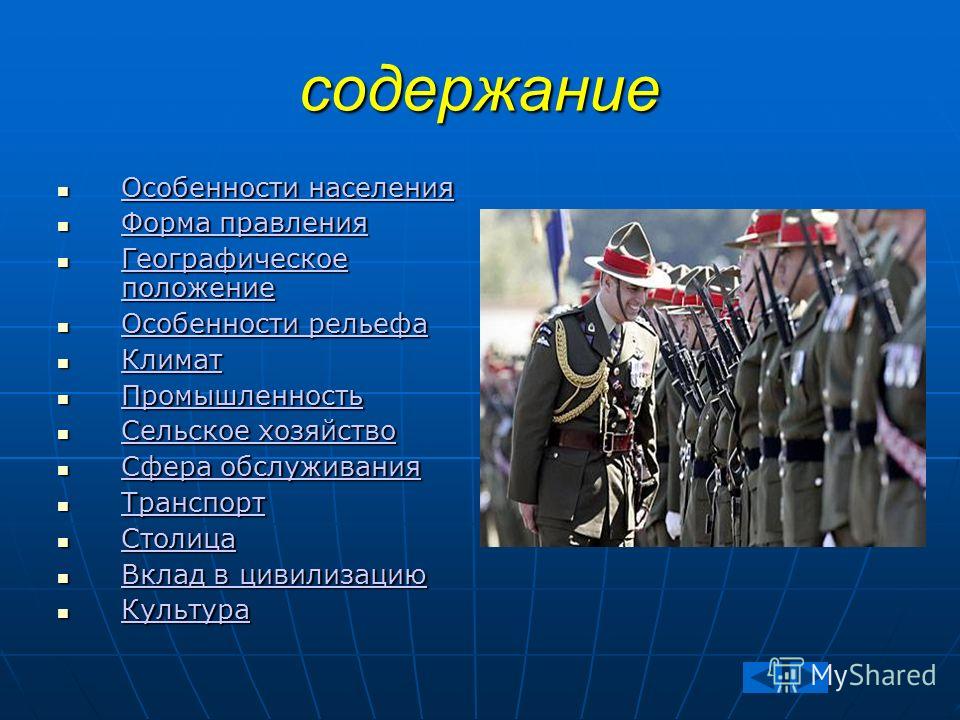
Площадь кв.км Площадь кв.км Население чел. Население чел. Средняя плотность населения 12 чел/кв.кмСредняя плотность населения 12 чел/кв.км Средняя продолжительность жизни: мужчины – 75 лет, женщины – 80 летСредняя продолжительность жизни: мужчины – 75 лет, женщины – 80 лет Состав: европейцы – 88% маори – 9% жители островов Тихого океана – 3% Состав: европейцы – 88% маори – 9% жители островов Тихого океана – 3%
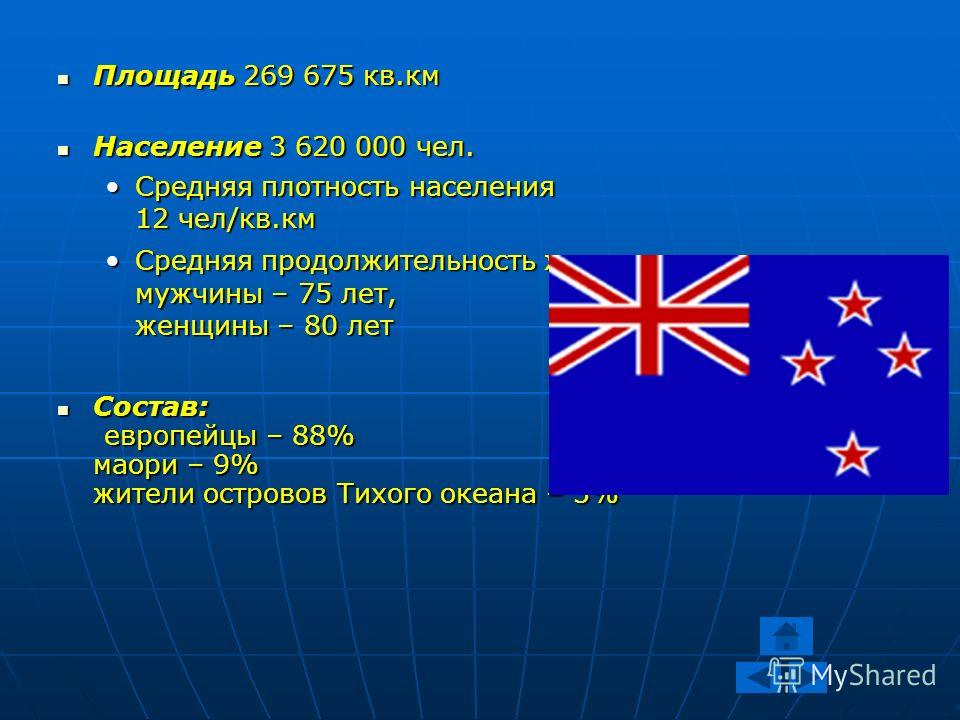
Форма правления: конституционная монархия Форма правления: конституционная монархия Глава государства: королева Великобритании, представленная генерал – губернатором Глава государства: королева Великобритании, представленная генерал – губернатором Государственный язык: английский Государственный язык: английский Религия: христианство Религия: христианство

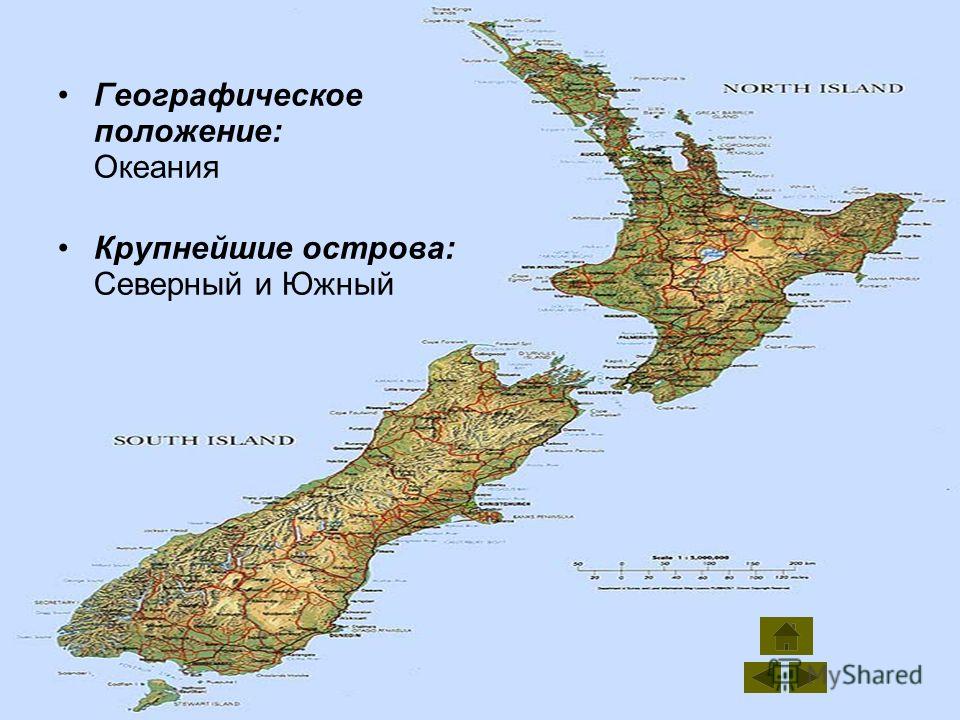
Климат: субтропический морской Средние температуры июля 5 – 12 С Средние температуры июля 5 – 12 С Средние температуры января 14 – 19 С Средние температуры января 14 – 19 С Осадки: мм в год Осадки: мм в год
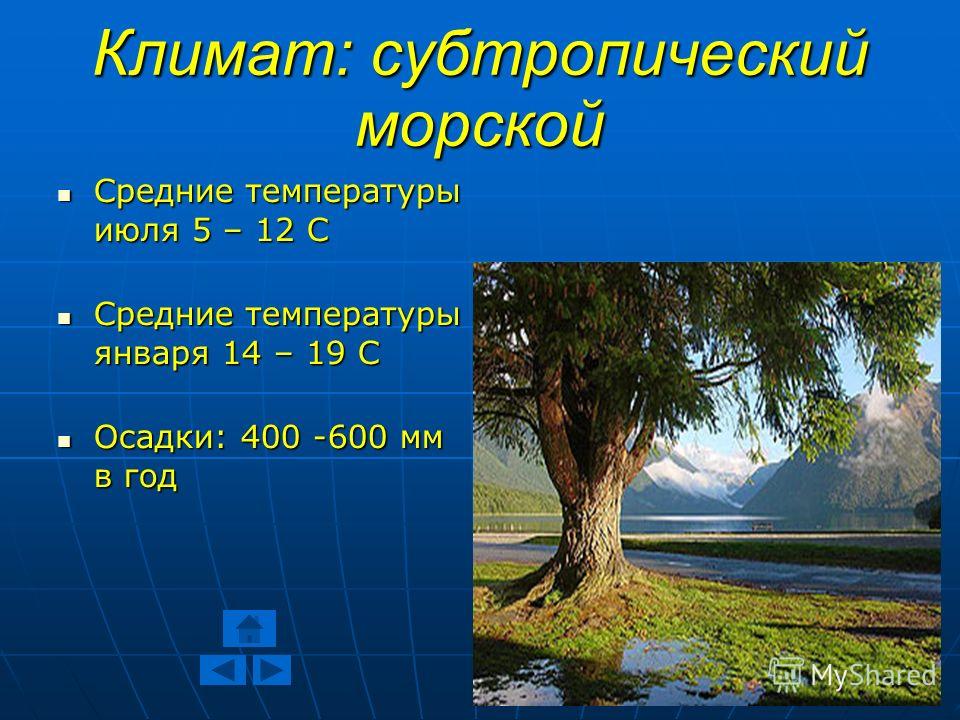
Промышленность Занято 19% трудоспособного населения Занято 19% трудоспособного населения Дает 31% ВВП Дает 31% ВВП Машиностроительные, металлургические и текстильные предприятия сосредоточены в крупных портовых городах Машиностроительные, металлургические и текстильные предприятия сосредоточены в крупных портовых городах
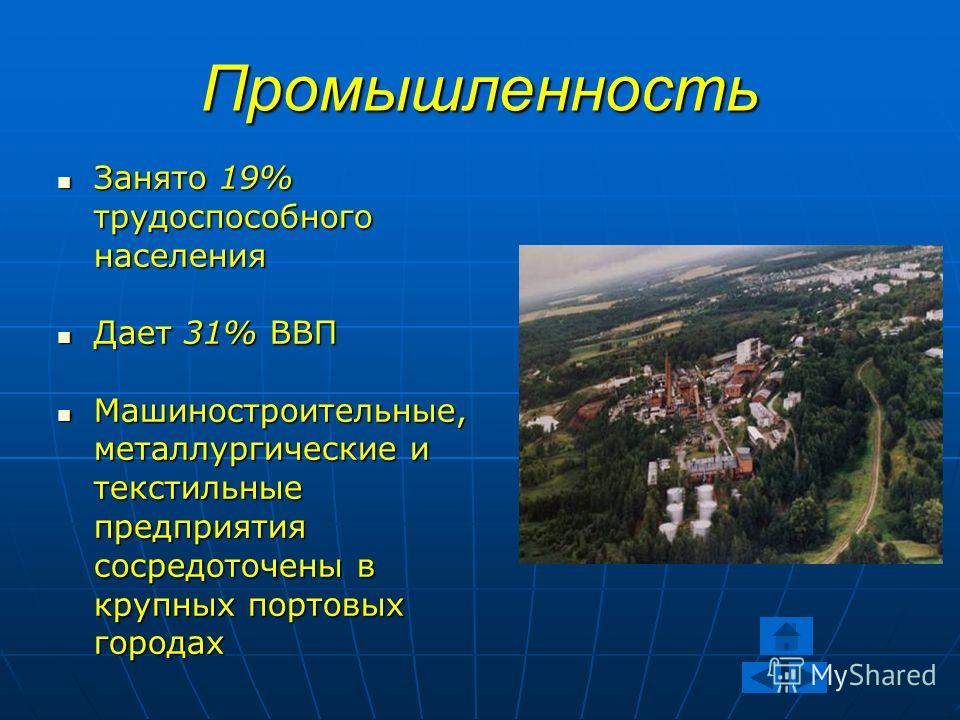
Сельское хозяйство 46% всего экспорта приходится на сельскохозяйственную продукцию: мясо, масло, сыр, шерсть 46% всего экспорта приходится на сельскохозяйственную продукцию: мясо, масло, сыр, шерсть Развиты лесное хозяйство, лесозаготовки, деревообрабатывающая, целлюлозно – бумажная отрасли Развиты лесное хозяйство, лесозаготовки, деревообрабатывающая, целлюлозно – бумажная отрасли
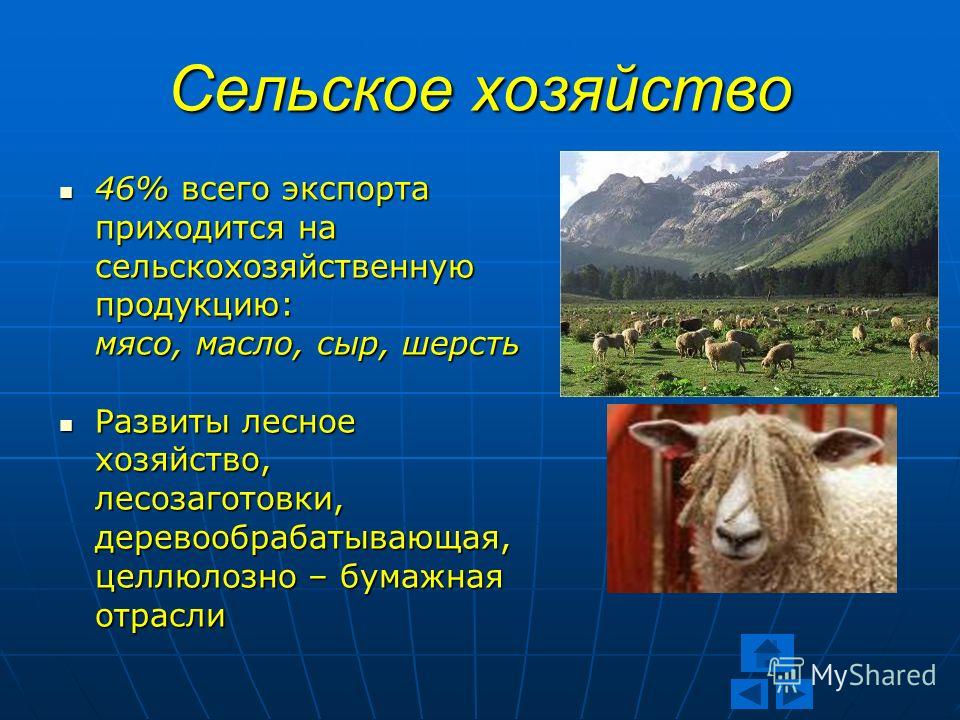
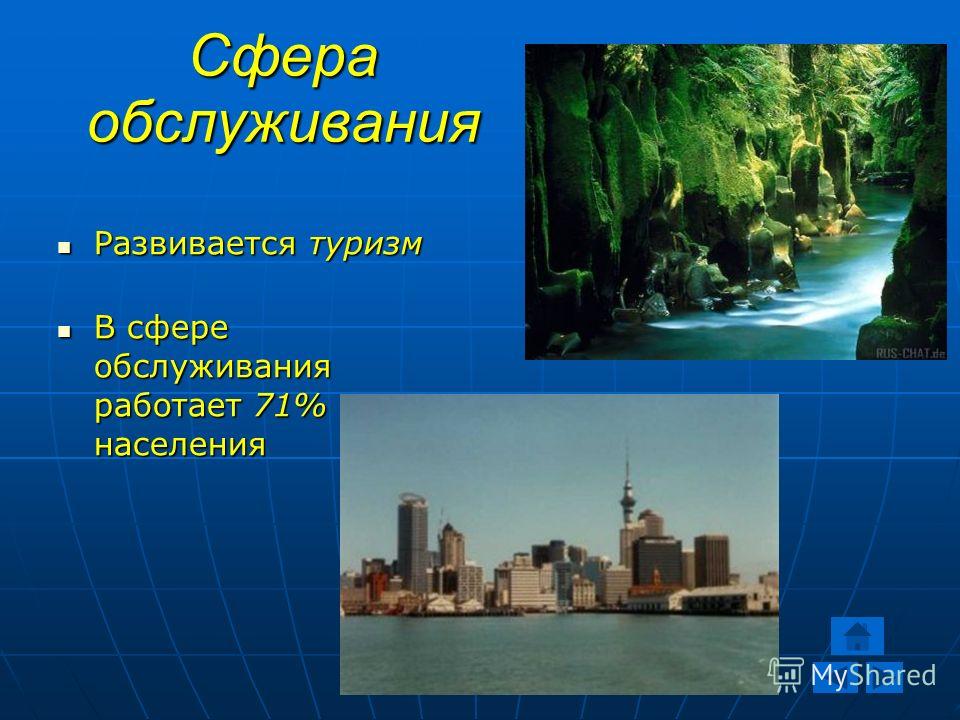
Транспорт Длина железнодорожных путей 4200 км Длина железнодорожных путей 4200 км Длина шоссейных дорог км Длина шоссейных дорог км Паромные маршруты Веллингтон – о.Южный Паромные маршруты Веллингтон – о.Южный Международные аэропорты: Окленд, Крайстчерч, Веллингтон Международные аэропорты: Окленд, Крайстчерч, Веллингтон Морской транспорт Морской транспорт
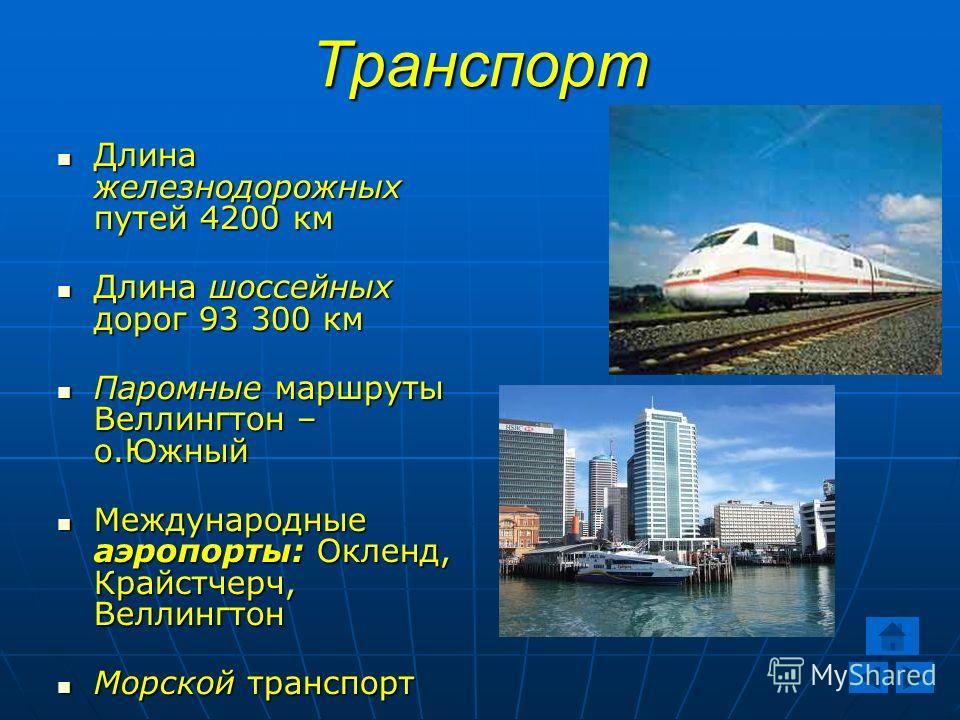
Столица – Веллингтон. Город расположен на северном берегу пролива Кука, в бухте Потр – Никольсон. Площадь125 кв. км. Население 158 тыс. чел. В сентябре 1839 года группа белых переселенцев приобрела у местного племени маори участок, на котором был построен город, названный в честь фельдмаршала Веллингтона, командовавшего английскими войсками в сражении при Ватерлоо.
Вклад в цивилизацию. Эрнст Резерфорд (1871 – 1937). Величайший физик – экспериментатор двадцатого столетия. Центральная фигура в познании радиоактивности, заложил основы ядерной физики. Его открытия получили широкий спектр применения, включая ядерное оружие, атомные электростанции, радиоактивные исчисления, исследования радиации.
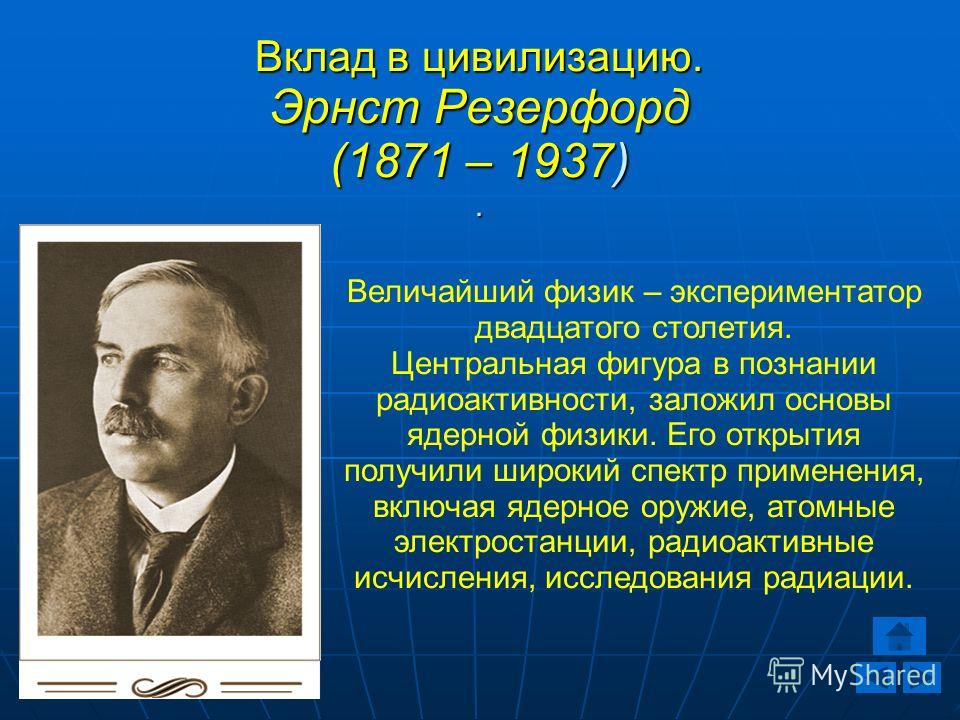
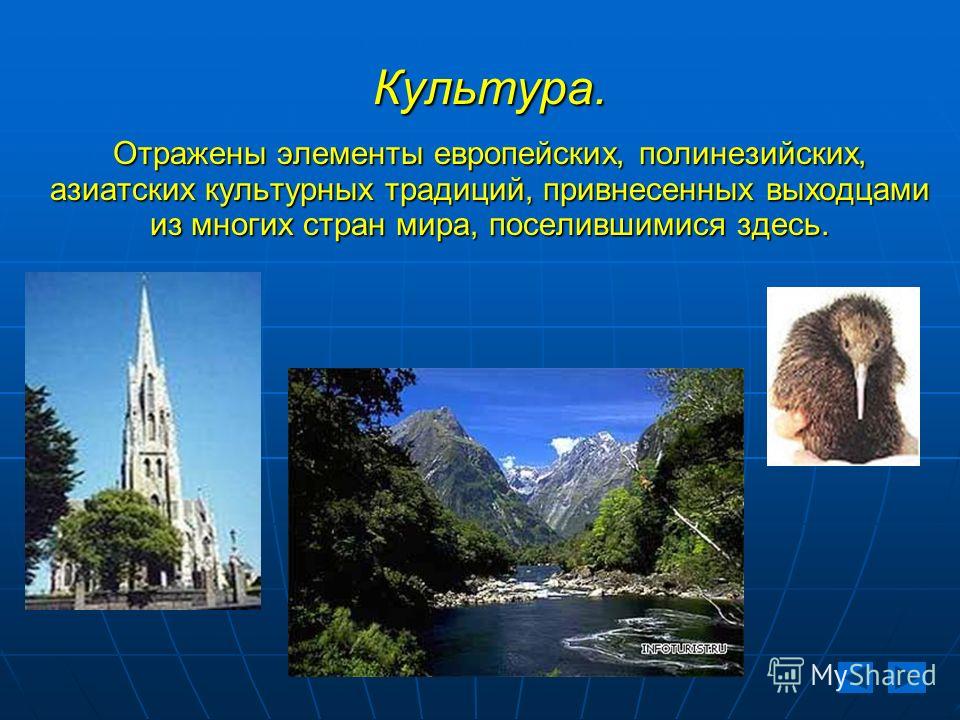

Слайд 1
Слайд 2
Official name New Zealand (English); Aoteraoa (Maori) Capital city Wellington Largest cities Auckland, Christchurch, Dunedin Total area 268, 680 sq km Population 4,116, 000 people Main religions Christian, Catholic Major ethnic groups Europeans, Maori, Pacific Islanders, Asian Consist of North Island, South Island, Stewart Island, Chatman Islands and minor islands Currency New Zealand Dollar (NZ$) Official language English, Maori Nationality a New Zealander (the New Zealanders) Form of government parliamentary democratic monarchy Natural resources land (for farming, dairy farming, cattle breeding), forests Flag the New Zealand Flag Internet TLD (top-level domain) .nz International dialing code + 64
Слайд 3
The map of New Zealand
New Zealand lies between the Equator and the South Pole in the southern Pacific Ocean, near the eastern coast of Australia. New Zealand is an island country with a total area of 268, 680 sq km. It has no land boundaries. Australia is New Zealander’s nearest western neighbour. These two countries are separated from each other by the Tasman Sea.
Слайд 4
The geographical peculiarities
New Zealand is made up of three main islands – the North Sea, the South Sea and the Stewart Island. The South Island is separated from the North island by Cook Strait.
The Stewart Island Cook Strait The North Sea The South Sea
Слайд 5
There are also such smaller offshore islands as the Chatham Islands, Campbell Islands, the Antipode Islands, the Bounty Islands and the Auckland Islands.
The Antipodes Islands The Kermadec Islands Chatham Island The Bounty Island Campbell Island
Слайд 6
It’s interesting to know…
…New Zealand is 12 hours ahead of Greenwich Mean Time (GMT). So, it is one of the first places in the world to see the new day. …The Maori people call New Zealand Aotearoa, which is usually translated into English as “The Land of the Long White Cloud”. …New Zealand is also called “Godzone”, “Pig Isles”, “Shaky Isles”, “Quaky Isles”, “Maoriland” and “Kiwiland” An interesting historical fact… The name “New Zealand” came from Dutch cartographers, who called the islands “Nova Zeelandia”, after the Dutch province of Zeeland. British explorer James Cook adapted the name to the English language and the name became New Zealand.
Слайд 7
Though the country is so small there are so many beautiful things that attract attention — volcanoes, subtropical rainforests, geysers, fiords, beaches, glaciers and high mountain peaks. New Zealand lies on the plates that make geological movements. Volcanic action still continues on the islands. Earthquakes are frequent here though they are not so damaging. The North Island has a number of large active volcanoes, among them is Ruapehu. The last eruptions were here in 1995 and 1996.
Слайд 8
Flora and fauna of New Zealand
Flora in New Zealand is very rich. There are about 2,000 species where 1,500 are endemic (which are only found in this country). It also has some of the oldest trees. Fauna in this country is also special. Long time ago, without enemies, some birds lost their ability to fly, and some insects became gigantic. It’s interesting to know… Before Europeans came to New Zealand there were no predatory animals at all. This was so good for many flightless birds. All wild mammals living in New Zealand at present were imported.
Слайд 9
Many of New Zealand’s native animals are found nowhere else in the world: the kiwi – its egg is about one fifth of its own weight the kakapo – the world’s largest flightless parrot the tuatara – the oldest living reptile Tuataras live for 300 years. They can be traced back 190 million years to the Mesozoic era
kiwi kakapo tuatara
Слайд 10
the biggest earthworms in the world the smallest bats in the world – the only native land mammals in New Zealand the weta – the heaviest insect in the world (70 gm and 20 cm long)
the weta New Zealand bat
Слайд 11
Rivers and mountains
New Zealand is a very mountainous country. About one third of the islands is covered with mountains. The Southern Alps run along the western coast of the South Island and are the highest in New Zealand. Mount Cook is the highest mountain there (3, 050 metres above the sea level).
the Southern Alps Mount Cook
Слайд 12
It’s interesting to know… Sometimes New Zealanders say that the North Island means “beaches” and the South Island means “mountains”
New Zealand’s rivers are mainly short and swift. The longest river is the Waikato. There are many lakes on both islands as well. The North Island’s volcanic interior contains New Zealand’s largest lake. Its name is lake Taupo.
Слайд 13
New Zealand is known for its maritime climate which is quite good during the whole year. It is moist, temperate and is affected by latitude and the proximity of the ocean. Climate of this country has no extremes and no wide range of temperatures. The difference of winter and summer temperatures is about 10 degrees. That is why New Zealand is very attractive for tourists. Seasons here are reverse of the Northern Hemisphere like in Australia. Because of New Zealand’s wet and mild climate many inhabitants of the country are busy with farming and dairy goods production. There are heavy rainfalls in New Zealand all year round which is very good for cattle –farming, sheep- farming, growing fruit, vegetables and flowers.
Слайд 14
More than 85 per cent of the population of New Zealand lives in urban areas. The principal country cities are Wellington (the capital), Auckland, Christchurch, Dunedin, Hamilton, Palmerston North, Hutt City, Invercargill. Early in the 20th century the first four mentioned cities were almost equal in importance but then they started to develop rapidly except for Dunedin. Wellington is the capital of the country, its second largest city, the main port, the centre of finance and commerce and a sit of the government. It is situated on the southern coast of the North Island. The population of greater Wellington is about 350,000 people. Wellington has been the capital of the country since 1865.
Слайд 15
An interesting historical fact… Wellington’s nickname is “the windy city”. The first European name of the city was “Port Nicholson” named after a captain of the British navy who in 1839 bought the land from the local Maori tribe in exchange for blankets. In 1840 the first settlers arrived from Britain and called this settlement “Britannia”. And “Britannia” later became “Wellington”.
Auckland is New Zealand’s largest city and its former capital. It has a population of over a million people. Auckland was first established as the capital of the British colonial government. Despite the fact that Auckland is much larger than Wellington it is geographically less central. So, this was the major deciding factor for transferring the capital to Wellington. Christchurch and Dunedin are two main cities of the South Island. These cities are very much like British ones because of their atmosphere.
Слайд 16
The population of the country
the Maori – маори, представители полинезийской расы, аборигены Новой Зеландии. The population of New Zealand is over four million people. It is unevenly distributed. The main part of the population lives on the North Island which is obviously closer to the Equator and warmer. About 50 per cent of the population lives in four cities of Auckland, Wellington, Christchurch and Dunedin.
It’s interesting to know… Arthur Lydiard, a New Zealander, invented jogging – the method of building physical fitness by increasing stamina gradually through running slowly. Bungee jumping was also invented in New Zealand.
Слайд 17
Almost 70 per cent of the population is people of European (mainly British) background. And about eight per cent is the Maori, New Zealand’s indigenous inhabitants or Aborigines. There are also small minorities of Pacific Islanders and Asians. The Maori originate from a Polynesian people from south-east Asia. The exact date of Polynesian settlement on islands of New Zealand is unknown. It could be between 950-1130 AD. The Maori tribes had lived on the islands of New Zealand for hundreds of years before the white people came there. Abel Tasman was the first European explorer who saw New Zealand in 1642. But captain James Cook, an Englishman, was the first who first set foot on New Zealand’s soil in 1769. After his voyages Europeans began to come frequently.
Слайд 18
An interesting historical fact…
Before Europeans came to the island, the tribes of Maori did not have the name for themselves. They adopted the name “Maori” meaning “normal” to distinguish themselves from Europeans.
The tribes of Maori are well-known all over the world. The Maori are famous for their folk-songs and wood-work. They are often called “Vikings of Sunrise”.
Слайд 19
In the 19th century there was a struggle between the Maori people and the British colonies. It was a series of the Maori Wars. Many of the Maori were killed and English settlers took their lands. Both English and Maori are official languages. English is more widely spoken, though the Maori language is now coming back thanks to the revival of their native language Maoritanga and Maori culture.
Слайд 20
The symbols of New Zealand
The symbol of New Zealand is the kiwi – a flightless bird, native to this country. Kiwi has no tail, almost no wings and is about the size of a large hen. No other bird lays eggs so large in proportion to its size: the egg is about one fifth of its own weigh. It means that in many ways the kiwi does not look like an ordinary bird. It is rare and very much protected.
It’s interesting to know:
The Kiwi as an emblem first appeared in the late 19th century. During World War I the name “kiwi” was used for New Zealand soldiers.
Слайд 21
Today, New Zealanders overseas (and at home) are called “Kiwis”. The Kiwi is closely associated with the Armed Forces. The green fruit with the brown skin that we call “kiwi” is known as “kiwifruit”. They often call small children “Kiwis”. In elementary school there are such posters with the words: “Be a tidy kiwi!” The bird is now used in the coat of arms, crests and badges of many New Zealand cities, clubs and organisations.
Слайд 22
As for the New Zealand Flag, the stars of the Southern Cross show country’s location in the South Pacific Ocean. The Union Flag shows that New Zealand was once a British colony.
Слайд 23
The New Zealand and Australian flags have very much in common. The only difference is that the Australian Flag shows the stars of the Southern Cross in white colour on a blue field while the New Zealand Flag shows the stars in red on a blue field.
Слайд 25
The political system of New Zealand
New Zealand is an independent state and a member of the Commonwealth of Nations and the United Nations. This country is a constitutional monarchy. The British monarch is the Head of State but Governor-General, usually a New Zealander, represents the Queen by carrying out responsibilities. The government consists of the Governor-General, the Prime Minister who is the leader of the party in power, Cabinet (executive branch) and the Parliament (legislative branch).
John Key, the Prime Minister
Слайд 26
The Parliament, contrary to the UK, consists of only one chamber – the House of Representatives. There are 120 members. Its members are elected every three years. The chief political parties are the Labour Party, the National Party and the New Zealand First Party.
Слайд 27
Some details of culture of New Zealand
The culture of New Zealand is a mixture of different cultures: British, Aboriginal and other European countries. Today New Zealanders are highly educated and sophisticated urban dwellers. There is a cultural phenomenon in New Zealand known as “kiwiana”. You know that New Zealanders are called “kiwis” around the world after the native bird “kiwi”. Now their “kiwi” sense of humor, “kiwi” view of life make up “Kiwiana”, which is all the special things and details that show their national identity, their “kiwi nationhood”. Kiwifruit, for example, was once known as Chinese gooseberry, but the fact that it was imported from New Zealand made world call this fruit – kiwifruit.
New Zealand is a very interesting country. It has got a total area of square kilometers. Новая Зеландия – очень интересная страна. Ее общая площадь составляет квадратных километров.
Two main islands It is situated to the south- east of Australia in the Pacific Ocean. It consists of two main islands(North Island and South Island) and some smaller ones. Она расположена на юго — востоке от Австралии в Тихом океане. Она состоит из двух основных островов (Северный остров и Южный остров) и нескольких более мелких.
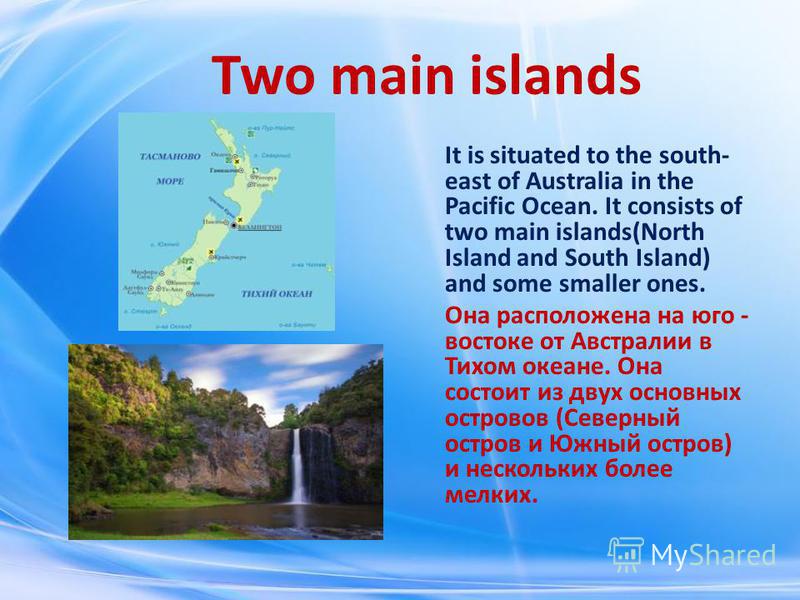
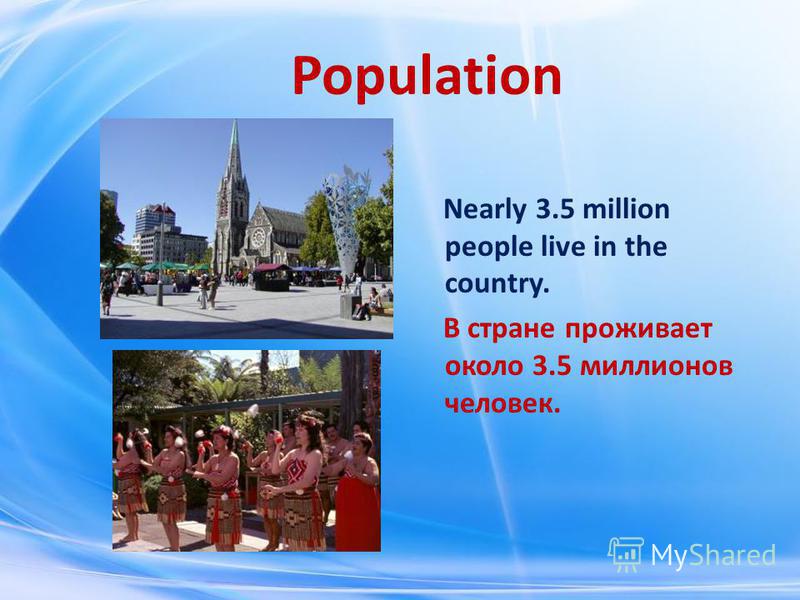
The capital The capital of New Zealand Island is Wellington. It is a financial centre too. The city was founded in 1840 and has been the capital since Столица Новой Зеландии — Веллингтон. Это также финансовый центр. Город был основан в 1840 году и является столицей с 1865 года.
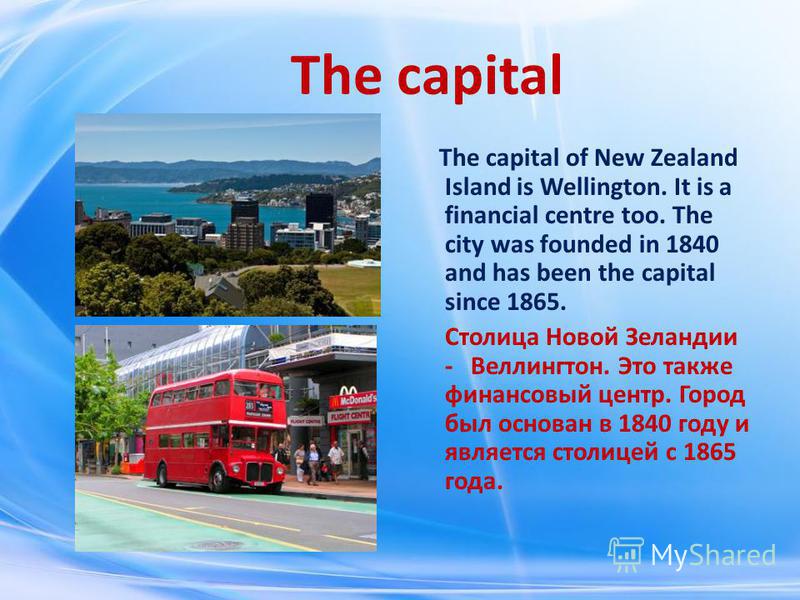

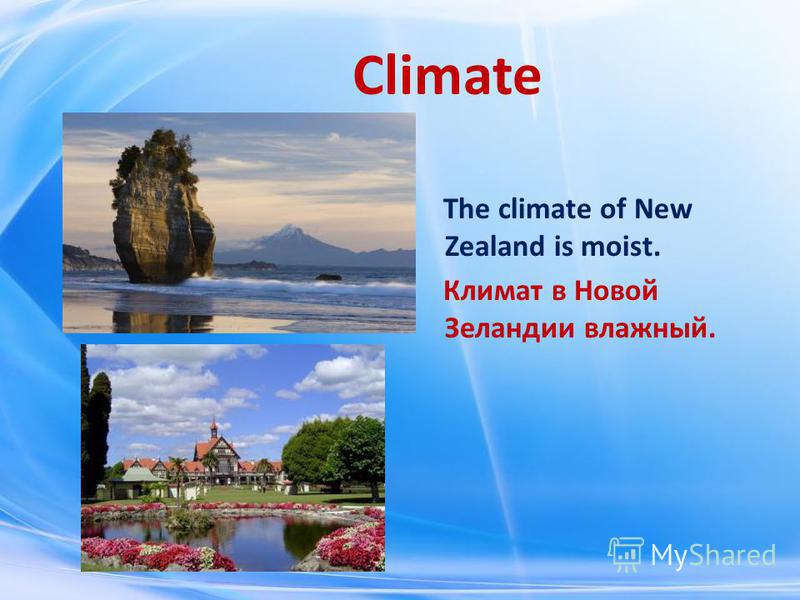
Major industry New Zealand is rich in minerals. There are some major industries in the country, for example, iron and steel industry. The country has gas and petroleum. Новая Зеландия богата полезными ископаемыми. Основная отрасль промышленности – металлургическая. В стране есть газ и нефть.

Mountains There are many mountains in New Zealand. The highest is Mount Cook (3.764 meters or feet). В Новой Зеландии много гор. Самая высокая – Гора Кука. Ее высота составляет метра или футов.
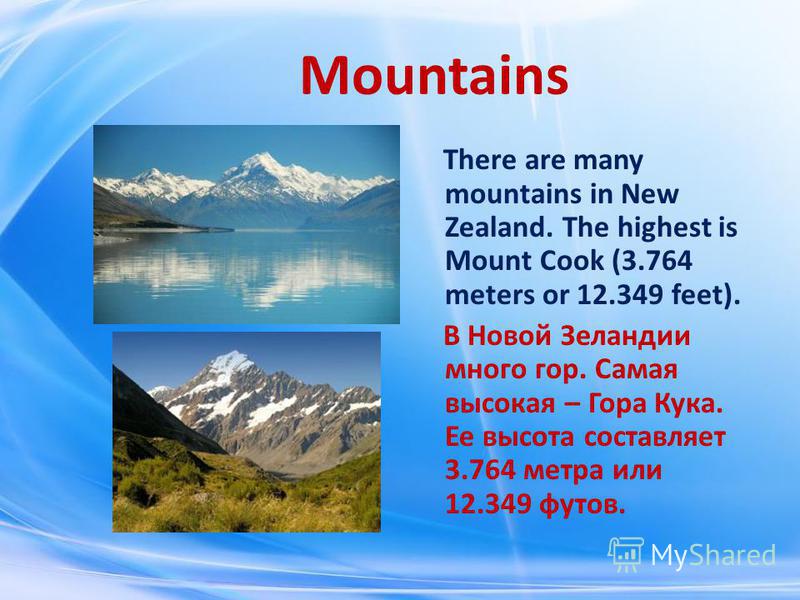
Rivers and lakes There are many rivers and lakes in the country. The chief river is the Waikato. Lake Taupo is the largest lake in New Zealand. В стране много рек и озер. Основная река – Уаикато. Озеро Таупо является самым большим озером Новой Зеландии.
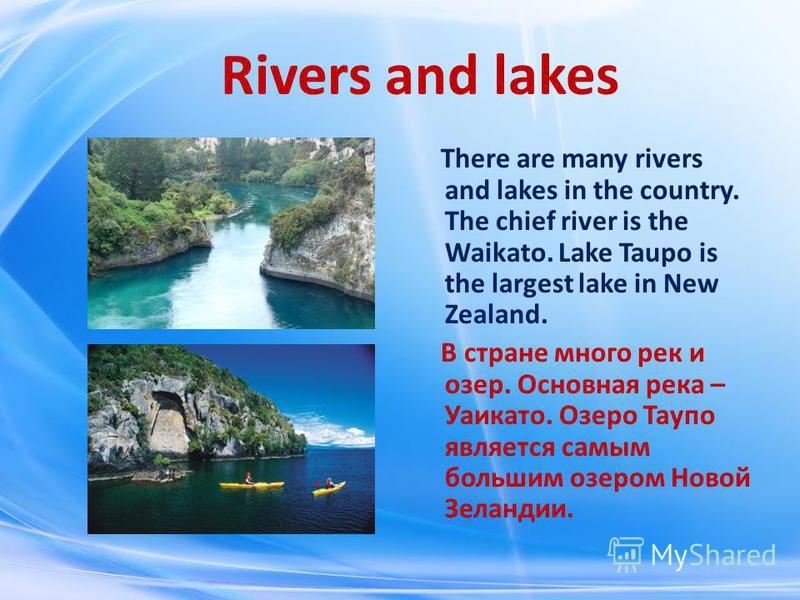
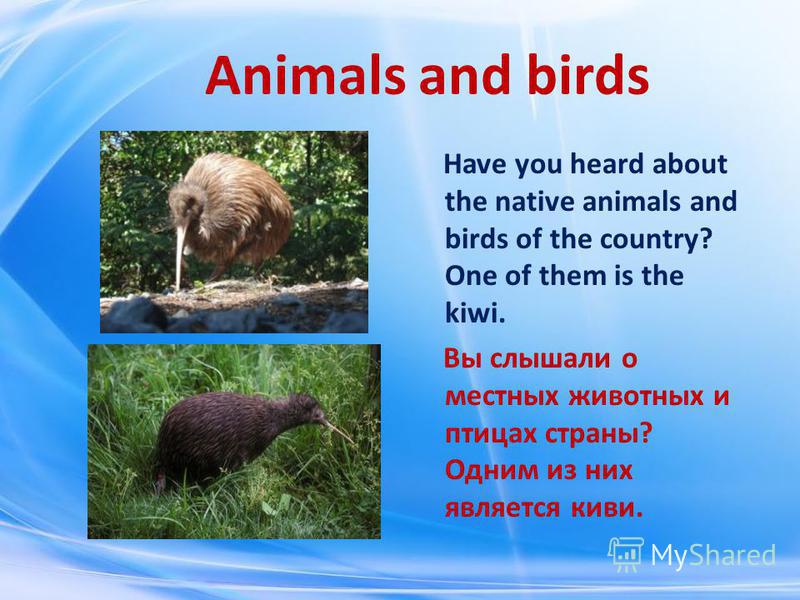
Kiwi This interesting bird lives in the wet pats of the thick bushes. In the day-time the bird does not go out. It comes out only at night to find food. Kiwis cannot fly. Эта интересная птица живет в мокрых густых кустах. В дневное время птица не выходит на улицу. Она выходит только ночью, чтобы найти пищу. Киви не умеют летать.
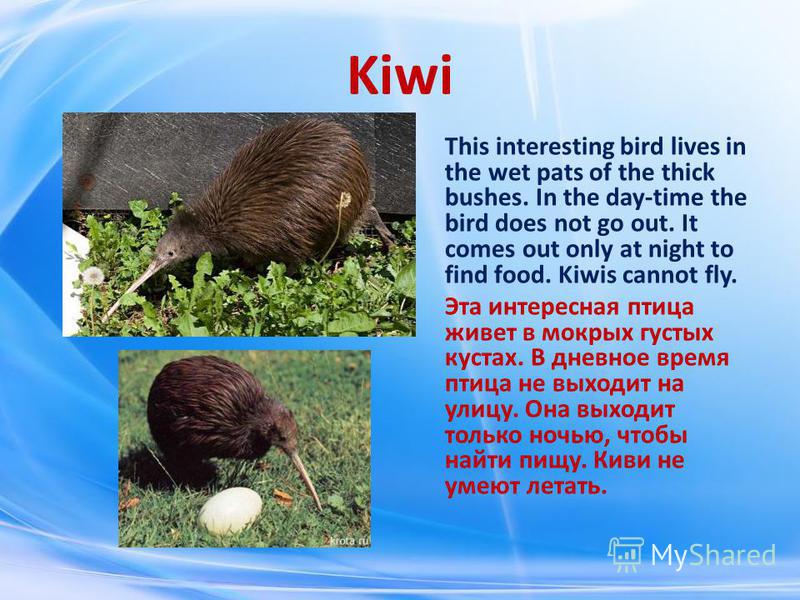
Kiwi Many years ago kiwis were hunted for food. Now the government does not permit the hunting of kiwis. The kiwi is now the symbol of New Zealand people. Small children are often called kiwis. Много лет назад на киви охотились для пищи. Теперь правительство не разрешает охоту на этих птиц. Киви теперь является символом Новой Зеландии. Маленьких детей часто называют киви.

Independent state New Zealand is an independent state, yet formerly it was a part of the British Empire. The head of the state is the Queen. New Zealand is a self-governing state. Новая Зеландия является независимым государством, но ранее она входила в состав Британской империи. Главой государства является Королева. Новая Зеландия — самоуправляемое государство.
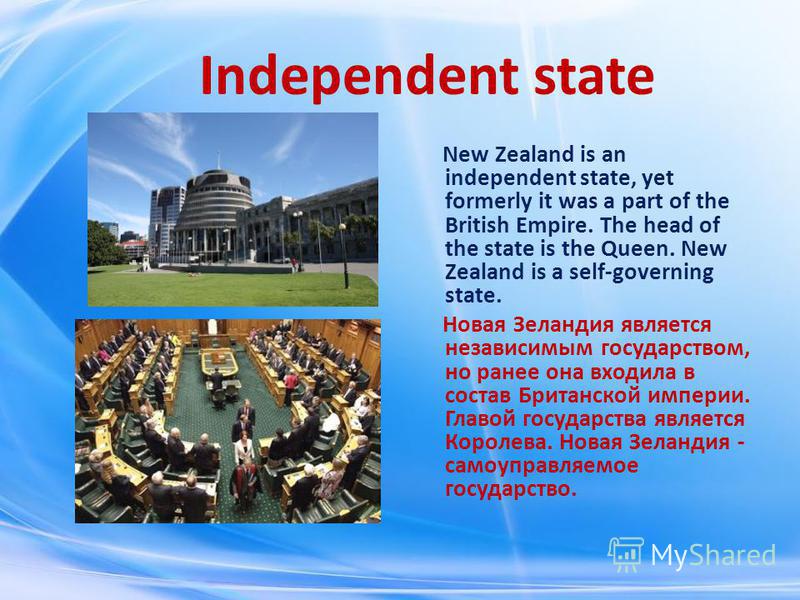
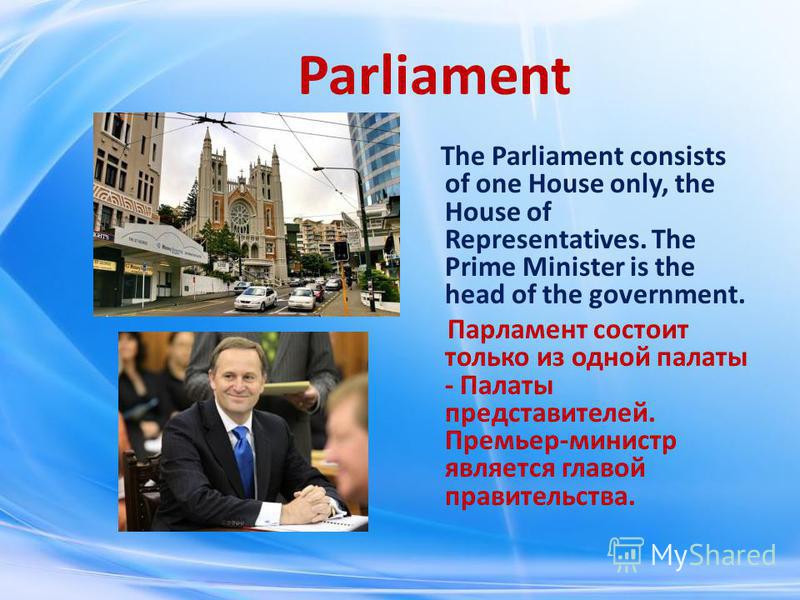
Industry New Zealand has got heavy industry. There are many plants in the country. Paper and rubber industries are developed too. New Zealand exports wool, meat, butter. В Новой Зеландии есть тяжелая промышленность. В стране имеется много заводов. Также развиты бумажная и резиновая отрасли. Новая Зеландия экспортирует шерсть, мясо, масло.

Big cities There are some big cities as Auckland, Wellington, Christchurch, Dunedin, Nelson. Auckland and Wellington are the main ports of the country. Крупными городами страны являются Окленд, Веллингтон, Крайстчерч, Данидин, Нельсон. Окленд и Веллингтон являются основными портами страны.
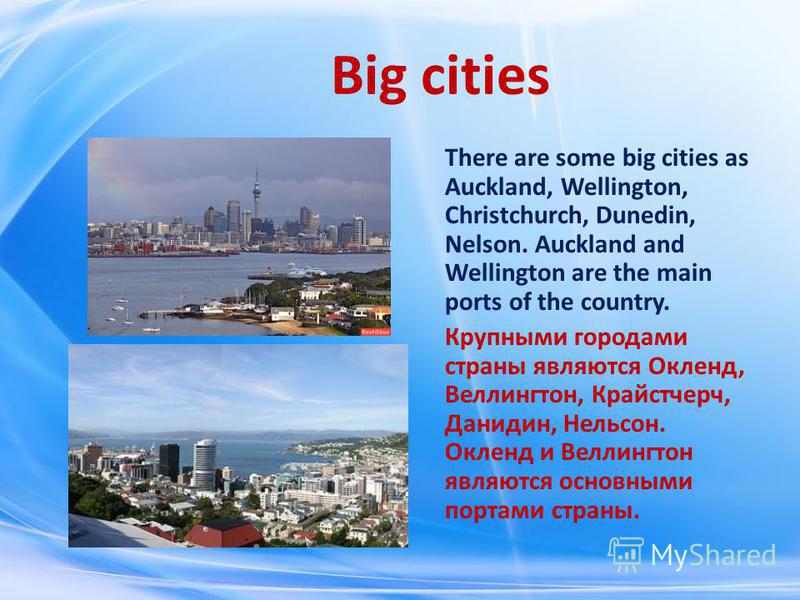
Educational and cultural institutions There are educational and cultural institutions in Wellington. They are the University of New Zealand, Victoria University College and others. Victoria University was established in В Веллингтоне есть образовательные и культурные учреждения. Это Университет Новой Зеландии, Университетский Колледж Виктория и другие. Университет Виктории был создан в 1897 году.

